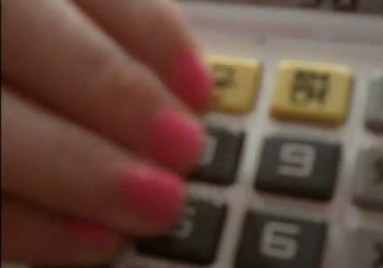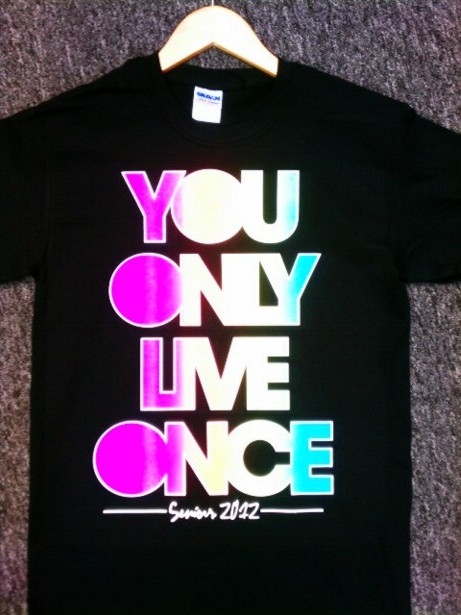I have been down the shore on vacation for a little while, so I have been by and large away from the Internet. Since I don't have a smartphone, I can still think of the Internet like that, as a place I can be "away" from. (It also
means that probably 99% of what I write about smartphones is silly. See below.)But on the boardwalk, I didn't feel too far away from the Internet. Alongside the One Direction and Phillies/Irish-heritage-related shirts and the hot pants that had slogans like "This Butt Belongs to Billy" embossed on them, all the stalls were selling YOLO T-shirts. I'm probably wrong to associate YOLO with social media, but in my mind, one demands the other. YOLO is gratifying only in a "pics or it didn't happen" world, or in a world where next to nothing you do is destined to be private, so it may as well be outrageous. Hyperdocumentation makes us all aware of the one life we've chosen and leaves less room to imagine alternatives.
When my friends and I talked about which of the boardwalk T-shirts we'd buy if we had to choose one, I decided I'd probably go with the anti-YOLO option (left), after flirting with the possibility of "Let's Get Weird."

I kept wondering though, Does it betray the spirit of YOLO to wear a YOLO T-shirt, or does it exemplify it? Was the boardwalk the best sort of place to only live once? When you are there, do you even have to announce that that is what you're aspiring to? Much of the point of the boardwalk is to let teenagers who have come from different towns mingle as if they were born yesterday, tanned and sans personal history. The sense of possibility is palpable, and the idea that one can try too hard is suspended amid the garish neon, the skimpy clothes, the frozen custard and the flood of stumbling strangers bumping into one another, their eyes continually drawn to watch anything other than where they are going.
While I was playing Skee-ball, one of my friends watched somewhat dumbfounded as a couple of teenage boys tried to pick up some girls at the bench beside him. He said he saw the boys and girls talk for a few minutes, and then the boys were putting numbers in their phone, and then they walked away. When they were a few yards away, they were already texting the girls they were just talking to, who were checking to see what they had received on their phones and were looking back at the boys and laughing.
I know it's a stupid question to ask why the teenage boys didn't just stay there and continue talking to the girls. It's certainly a lot easier to advance things by text, where you can create immediate one-to-one intimacy that is at the same time safely cushioned by distance. You can flirt without your or their friends laughing at you and discouraging the process; you can let the technology disinhibit you. When I was a teenager, you had to steal booze to accomplish that. Going to the boardwalk, or its pale imitator, the mall, wasn't enough to disinhibit me; it just made the need for disinhibition seem more acute, impossible to ignore. It made inhibition feel like failure.
My friend and I fell into reminiscence mode, recalling that what few numbers we summoned the courage to procure would always be called hours if not days later, and you never knew who would answer: the girl, her parents, or some unsuspected random stranger whose number you were given to get you to buzz off. There was no way to immediately create that intimate communicative space; all the lines of communication had apparent overseers.
danah boyd pointed out in this 2008 post (thanks @tylerbickford for the link) that "given the structures of their lives, teens have often had very little control over their social context. In school, at home, at church… there are always adults listening in." She argues that cell phones are the latest technology to offer "interstitial spaces" to teens in the "arms race" for privacy against parents' surveillance. Texting is "more effective as a backchannel mechanism than whispering," she writes. But the interstitial space has become an all-enveloping one, and has allowed a different kind of surveillance to emerge.
I'm quick to complain about social media as lateral surveillance, but that's mainly because smartphones, etc., promise and prey on our expectations of a genuine privacy unlike what previous generations could ever take for granted. (That's why at least some of older people's privacy fears for younger people can be attributed to jealousy. I'm always falling into the trap of thinking the kids today are having so much more fun than I ever did and then resenting them for it. And then while I am at it, I resent their music and their fashion and their Facebook pages and everything else.)
People now enjoy an experiential privacy that's anchored to their phones that defies the reality of ubiquitous capture and the potential reproduction of whatever we say or type. Though that privacy is technically illusory, it is nonetheless a significant advance over the condition kids previously dealt with, an equally illusory sense of being watched carefully all the time and having nowhere to escape to.
I think that the experiential privacy that smartphones supply has all sorts of ramifications that are only beginning to emerge. Sure, phones augment our experience of everyday life, but they also create a new space in which we can live more of our lives apart from everyday reality, but not in a Second Life, virtual-reality sort of way. Rather, it seems a space of psychic retreat, regression.
What little time I've spent online the past few days has mostly been spent watching ASMR (autonomous sensory meridian response) videos for a writing project and waiting for the brain orgasms that never came. Who needs the beach when you can watch someone fondle a calculator?

It occurred to me that if ever any videos were designed to be watched on smartphones, it was these sorts of things. This is what "efficient whispering" looks like.
When I first read about ASMR in this article, I took it as a basically aesthetic response that had something to do with outsider art and post-authenticity and surrendering to the "boring" in a space beyond judgment, but upon further review, I am starting to think it is an aesthetic optimized for the smartphone, for the cloistered, womblike intimacy it seems to aspire toward. Perhaps ASMR can become the new New Aesthetic -- except those susceptible to feeling ASMR's tingling jolts while listening to crinkling noodle packages and droning voices tend to see their response as more of a reflex than as art appreciation.

The videos of people whispering rhythmically and role-playing as commercial caregivers seem well suited to the fantasy of the phone as not a mere device but a close friend -- actually something better than a friend, because the implied relationship is liberatingly impersonal and nonreciprocal: The phone cares for you and you don't have to care back, just like the people we pay to cut our hair. The videos also evoke another one-way relation, of infinite care and infinite helplessness, tapping into smartphones' latent infantilizing tendency, how it threatens to smother with its assiduous concern and pre-emptive sensitivity to our needs.
So while the intense documentation opportunities smartphones present us with prompt a certain extreme performativity, resigning us to live without regrets because we might regret everything for reasons we can't anticipate as things get de- and recontextualized, the devices also lease us a womb and offer a mother's insulating protection. Beyond "you only live once" is the fantasy of never having to be born.
